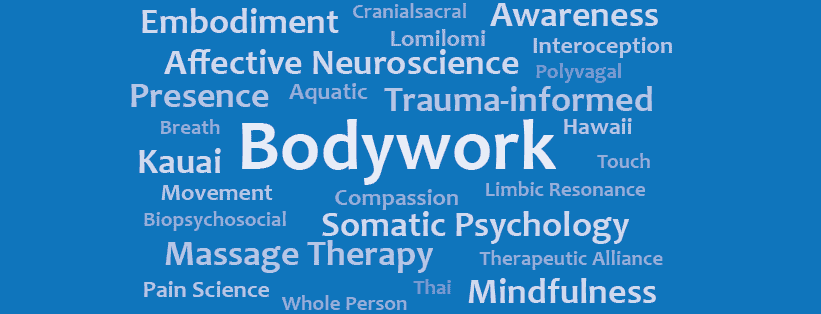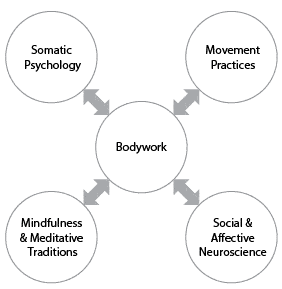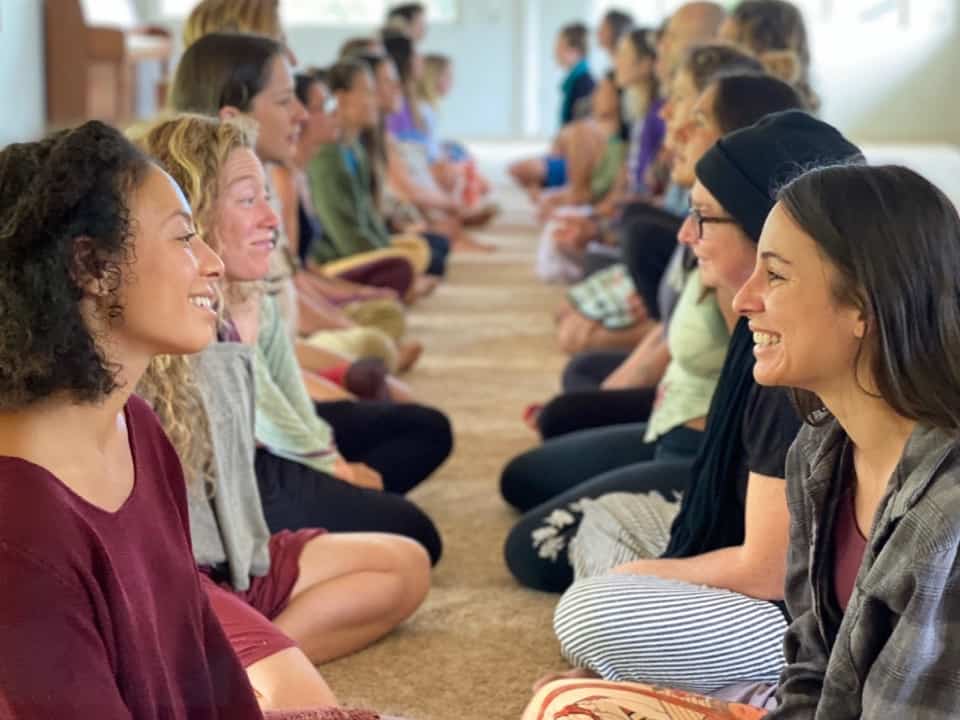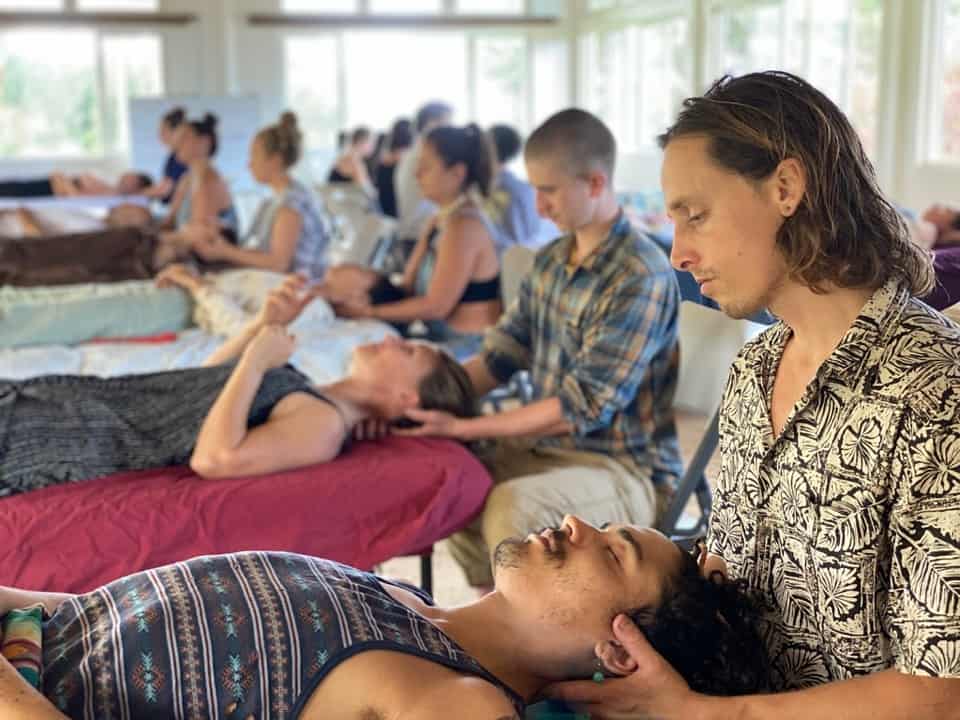Overview
Our Trauma Informed Massage Therapy Training Program (aka Relational Bodywork Program or Somatic Bodywork Program) is designed to facilitate the growth of highly skilled bodywork professionals. We offer everything one would expect in a bodywork program (e.g. massage theory and practice, human sciences, professional development), including a strong focus on practitioner cultivation and the honing of therapeutic relational skills derived from somatic psychology, affective neuroscience, and contemplative practices and offered within a trauma-informed context.
A New Approach to Massage Therapy
Our approach centers around two primary themes: A trauma-informed/relational theme and a neuro-centric theme:
Trauma-informed/Relational
Heart-centered: All the fanciest techniques in the world don’t matter if the therapist doesn’t truly care about and value their client. In fact, a great deal of evidence suggests that caring is more important than techniques, whether one is a doctor, psychologist, or massage therapist. This is where the work starts.
Trauma-informed: Our program is trauma-informed because trauma is relevant to everyone. Any institution can be trauma-informed, but it’s absolutely essential for a massage program. On the simplest level, we teach what trauma is, how it shows up, and what to do when it does, because a bodywork session involves many unique components that can be challenging for clients. The touch component alone can bring up issues more readily than one might experience in a psychotherapy setting. So, it’s important that we as bodyworkers are professionally educated about this. But beyond the more obvious trauma responses, we also want to understand the role of developmental trauma on client behavior and how it affects somatic aspects of the client that may be relevant to the client’s physical symptoms. This makes us better bodyworkers in the usual sense, but understanding client behavior also makes us more compassionate human beings, which again makes us better bodyworkers. The trauma component is also relevant to exploring ourselves and how to get out of our own way in the therapeutic relationship with our clients. And lastly, we’ve designed not just the content but also the delivery of the curriculum in a manner that takes into deep consideration how to build a sense of safety and when to offer specific exercises.
It’s important to mention that it’s no small feat to create a program that is both somatic and trauma-informed because much of what still constitutes somatic (and mindfulness) practices is characterized by a great deal of inadvertent re-traumatization and illusion of positive change. We take this topic very seriously so that we do no harm and we maximize our effectiveness with clients.
To read more on this topic, please read our page on what it means to be a trauma-informed program and read the Massage and Fitness Magazine article by our Director on Why Massage Therapy Needs to be Trauma-Informed.
Client-centered/Relational: If we care about our clients, we put their well-being first, and we don’t see them as someone to “fix” or apply a pre-fabricated plan upon. PCAB graduates become skilled at hearing what the client wants, collaborating with the client to establish goals, and fine-tune the offering during the session by tracking client responses at a variety of levels. This collaboration and goal-setting (Shared Decision Making) supports client agency, which is a key component of a trauma-informed offering.
Curiosity, Humility, and Listening: In order to be truly client-centered, we must avoid imposing our agendas, egos, and preconceived ideas onto the client, and we should instead embrace an attitude of curiosity and humility, which allows us to truly listen (with our ears, eyes, hands, and “hearts”) to what the client needs. This skill, another element of being trauma-informed, is more involved than it sounds and is fundamental to everything we do.
Neurocentric
Neurocentric: As bodyworkers, we don’t change anatomy. We change the nervous system. We recognize that everything in a session, from how we touch to how we communicate to what beliefs and feelings the client brings to a session are all interacting within the nervous system to create the changes that occur in a session, whether these are changes in anxiety, pain, posture, embodiment, or movement. This means that the clients’ issues are probably not in their tissues, which profoundly changes how we engage with the client, manually and relationally. By moving away from a tissue-based approach, we are better able to serve the whole person. The biopsychosocial model and the neurocentric framework can further one’s effectiveness beyond most touch therapies alone because many client issues are patterned adaptations to a deeper issue (not a deeper tissue).
Evidence-based Practice (EBP): PCAB offers professional instruction in standard bodywork modalities such as Swedish, Lomilomi, Shiatsu, Thai, and slow-touch, deep-listening therapies often associated with Structural Integration, whose principles permeate the entire program. Our assessment and clinical reasoning process is based on the latest (neuro)science of touch and interoception. Ultimately, there are only so many ways to touch the body, so while we offer separate modalities, our emphasis is to make you skillful in a broad variety of touch styles so that you can apply them in a customized manner that is most appropriate for exploring your client’s goals. By staying focused on the latest scientific evidence of how massage therapy works we maintain academic integrity and humility.
Biopsychosocial (BPS)/Holistic: Our approach to working with clients gives equal consideration to the bio-psycho-social components of a session. We are working with a whole person, not just a shoulder or tissue….and any physical issue may be influenced by psychological or social aspects of the client’s life, which may then become influenced by the physical issue. Touch is incredibly powerful, and touching the body becomes a doorway to the psyche and deeper aspects of the Self, while the psyche, in turn, determines how the body responds at each moment. Our BPS approach also means that the effectiveness of any session is affected by how we relate verbally and nonverbally with the client, not just how we apply our touch.
Interoceptive/Somatic/Embodied: We care about our clients’ internal sense of feeling good more than an external arbitrary measure of looking good (e.g symmetrical or “balanced”). Our focus is to assist the client in feeling as good in their body as they can and feeling able to do the things they want to do, without limitation. This focus can often help clients (re-)connect with what really matters to them.
Pain-Science-informed: Our graduates learn the latest neuroscientific understanding of what pain is and how it works, which means that they graduate with a much more sophisticated understanding of chronic pain than most health-care professionals have. To learn more about this topic, please read this article on descending modulation by our Director in Massage and Fitness Magazine.
Mindfulness: We encourage the enhancement of somatic awareness as an important step towards re-patterning one’s cognitive, emotional, and behavioral habits. As a result, a bodywork session can become a somatic guided meditation–a meditation guided not by voice but by touch. As one experiences novel sensory inputs and comes into greater awareness of those somatic inputs, one may gain new access to parts of oneself and feel an increase in a general sense of well-being and functionality.
Other Considerations
Each week of the program offers a blend of experiential anatomy, technique and session demonstrations, giving and receiving of bodywork sessions, and opportunities for practitioner cultivation (either individually, in pairs/triads, or in small/large groups).
Our graduates become skillful in generating non-specific effects (e.g. well-being, embodiment, aliveness, easefulness) as well as addressing specific client symptoms related to injuries, rehabilitation, pain reduction, and mobility. To be effective in either realm, specific or non-specific, involves the honing of both one’s touch skills as well as one’s verbal and non-verbal skills in therapeutic relating, which further requires cultivating oneself so that one doesn’t get in one’s own way of providing an optimal encounter with the client. All of this could be summarized as “deep listening”–to the client’s words, to the client’s body, and to one’s self.
Through the use of therapeutic touch, heart-centered language skills, and the presence of the therapist and client, we can foster relaxation and possibly connect with our true Selves more fully. As we come to know our Self more fully, living from this place naturally occurs more easily. These tools are all utilized to help reduce pain and limitations and to grow agency and resilience. In this way, our bodywork offerings can have a profound impact in making the world a better place, one client at a time.
Please be sure to read our page on Somatic Psychology, Affective Neuroscience, and Contemplative Practice for a more extensive description of this core element of our massage therapy training. Check out student testimonials on the value of our program.
Many people want to attend our program but are unable to do so for various reasons. For this reason we offer most of the content that makes us unique via online classes. Please explore what we offer online on our Continuing Education page–you don’t have to be an LMT to attend these classes.
Program Details |
|
| Dates | January 6-June 27, 2025
|
| Hours | 740. Meets the licensing requirements of most states. |
| Location | Princeville, Hawaii |
| Tuition | See Tuition Page |
| Licensing | Our program is licensed by the Hawaii Department of Education and is approved by NCBTMB. |
| Catalog | School Catalog |
| How to Join | |
The program includes:
- Massage Theory and Practice
- Human Sciences: Anatomy & Physiology, Kinesiology, Pathology, Neuroscience
- Professional Development (including Ethics, Communication, and Business)
- CPR & First Aid*
*Individuals who opt out of CPR & First Aid complete the program with 8 fewer hours.
Upon completion of this program you will be eligible to sit for licensing in Hawaii and most other states. You will have the skills and knowledge to help people in an enjoyable, beneficial, and professional manner.
Primary Topics
- Massage Theory and Practice: Typical options include Swedish, Lomilomi, NMT, Thai, Connective Tissue Massage, Cranialsacral, Aquatic, and others). Includes Assessment, Clinical Reasoning, and Student Clinic.
- Human Sciences: Anatomy, Physiology, Kinesiology, Pathology, & Affective Neuroscience, with critical thinking throughout.
- Professional Development includes Ethics, Business, and Communication tools derived from an evolving, trauma-informed synthesis of methods based on Gestalt, Somatic Experiencing, Interpersonal Neurobiology, NeuroAffective Relational Model, Reflective Listening, Authentic Relating, Motivational Interviewing, Hypnotherapy, Breath-oriented therapies, Mindful Movement practices, Eastern & Western Transpersonal & meditative Awareness practices, Vipassana, Advaita Inquiry, and others.




